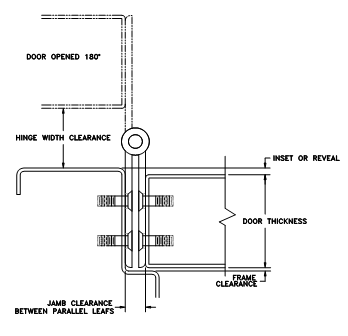View as PDF
American National Standard for Continuous Hinges
ANSI/BHMA A156.26 establishes requirements for architectural continuous hinges used in building construction. Cycle, finish, abuse, overload, vertical wear, and strength tests are included. For further information about hinges, consult the full standard, ANSI/BHMA A156.26 for Continuous Hinges.
BHMA has created this series of Hardware Highlights to provide useful, accessible information about Builders Hardware for architects, specifiers, builders, building code officials – anyone with an interest in the devices that hang, control, secure, and trim the doors.
BHMA is the North American Trade Association, which represents almost all the North American manufacturers of Builders Hardware. One of their main activities since 1983 has been the development and maintenance of ANSIapproved standards for 35 separate product categories.
Product Performance: Purchasers of hinges certified to A156.26 (http://buildershardware.com/cpd) can be assured products will perform to their expectations.
Below are an explanation and some examples of the evaluations conducted for certification:
The standard contains a full set of terminology relating to continuous hinges. Definitions such as "Half Edge Mounted. Having one leaf applied to the surface of the butt edge of the door and the other leaf applied to the face of the door frame" helps users to accurately specify and order hinges.
Obviously building products are expected to last a long time and builders hardware is no exception. Grade 1 hinges, for example must pass a rigorous test through 2.5 million cycles of opening and closing on a door of a specified weight.
Hinges may be specified with additional safety and security features as needed for the application. The standard defines hospitalhinges having sloped barrels, maximum security pins (MSP), and non-removable pins (NRP), among others
An additional duty of builders hardware is to be aesthetically attractive, and stay that way. Resistance to corrosion is evaluated through a salt spray test to ASTM B117 providing confidence in the ongoing appearance of the architectural metals and coatings.
Builders hardware provides several attributes that are essential to building safety and performance, including egress and fire protection. BHMA hinges are designed to comply with all applicable requirements. For example, hinges which are acceptable for fire doors are described in NFPA 80
Locksets contribute to building sustainability through their verified durability, as well as material characteristics such as recycled content and recyclability. The reliable closing and sealing of openings can also contributeto energy conservation. Continuous hinges are often used to extend the life of existing doors. BHMA has developed Product Category Rules, which further define sustainability requirements and guide life cycle assessments and environmental performance declarations.
|
Function Numbers and Illustrations
Another significant contribution of standards for product specification is a numbering system for hinge types. Please consult A156.26 for the full list; an example is provided here:
A13021B
Section A, brass/bronze material, full surface hinges, no electrical modifications, for a 300 lb. door, grade 1, barrel hinge.
|
 |